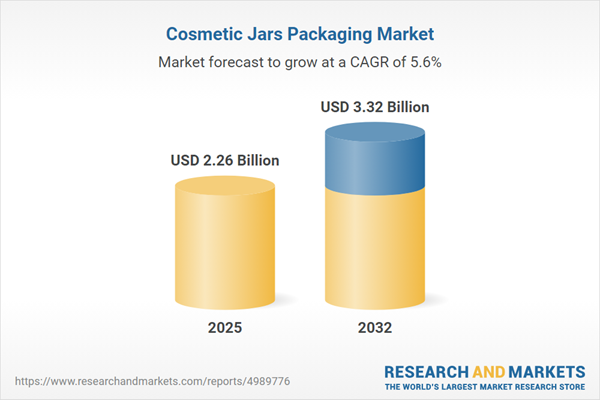Speak directly to the analyst to clarify any post sales queries you may have.
The cosmetic jars packaging market is undergoing rapid transformation, driven by regulatory dynamics, sustainability imperatives, and shifts in global supply chains. Senior executives increasingly require actionable insights to adjust sourcing models, mitigate compliance risks, and reinforce their organization’s competitive market stance.
Market Snapshot: Cosmetic Jars Packaging Market Trends and Growth
The cosmetic jars packaging market continues on a strong growth path, buoyed by rising demands for recyclable solutions and innovative manufacturing. Eco-friendly materials are moving to the forefront of product development as consumers and regulators prioritize sustainability. Technology integration, including smart and connected packaging, is optimizing supply networks and enhancing operational agility against global disruptions. These developments reflect a broader market shift toward designs that deliver both environmental value and end-user safety, positioning leading firms for emerging opportunities across international markets.
Scope & Segmentation of the Cosmetic Jars Packaging Market
- Material Types: Acrylic, ceramic, borosilicate glass, soda lime glass, aluminum, steel, HDPE, PET, and PP provide varied choices that support durability, recyclability, and compliance for manufacturers in this sector.
- Capacity Ranges: Single-use and large-volume jars are in demand for a range of distribution models, meeting the logistical needs of traditional retail, direct-to-consumer approaches, and e-commerce fulfillment.
- Finish Options: Frosted, glossy, matte, and metallic—including gold and silver—allow brands to differentiate their offerings, attract target audiences, and secure positions in both premium and value-market tiers.
- Applications: Packaging caters to fragrance, hair care, makeup, and skincare products. These specialized formats protect product integrity, such as creams and serums, while facilitating international market expansion.
- Color Choices: Options such as transparent, white, black, blue, green, pink, and red enable precise brand customization and connect with specific demographic preferences.
- Regions Covered: The Americas, Europe, Middle East and Africa, and Asia-Pacific present distinct compliance environments and consumer trends, requiring tailored strategies in eco-friendly design, branding, and premiumization.
- Leading Companies Analyzed: AptarGroup, Silgan Holdings, Berry Global Group, Amcor, Gerresheimer AG, Ardagh Group, Quadpack Industries, Lumson S.p.A., Tekni-Plex, and TricorBraun Holdings drive innovation, ensure supply chain agility, and set benchmarks for industry best practices.
Key Takeaways: Strategic Insights for Senior Decision-Makers
- Adopting innovative packaging materials and finishes amplifies brand engagement in both digital and brick-and-mortar settings.
- Switching to recycled or bio-based content strengthens supply chain resilience and anticipates evolving global environmental requirements.
- Embracing smart packaging technologies, such as NFC and augmented reality, enhances product protection and strengthens omnichannel consumer relationships.
- Digital manufacturing methods accelerate responses to changing consumer needs and streamline launches of new products for operational advantage.
- Applying data analytics in logistics supports timely and reliable distribution, reducing exposure to unpredictable market forces while maintaining efficiency.
- Regional customization—whether via sustainability initiatives or distinct material finishes—enables adherence to local requirements and meets shifting consumer expectations.
Tariff Impact: Managing Cost and Supply Chain Complexity
Recent United States tariffs on materials such as borosilicate glass, aluminum, and polyethylene terephthalate are leading manufacturers to revisit sourcing models and build domestic supplier partnerships. Senior leaders are focusing on risk management strategies and local sourcing to maintain regulatory compliance and production reliability amid a changing trade landscape.
Methodology & Data Sources
This analysis is informed by interviews with packaging engineers, procurement leaders, and compliance officers, supplemented by white papers, patent research, and focused industry surveys. This approach ensures the data and insights provided are both practical and directly relevant for executive decision-making within the cosmetic jars packaging sector.
Why This Report Matters for the Cosmetic Jars Packaging Market
- Executive teams gain insight to drive digital transformation, reinforce supplier networks, and boost readiness for market change.
- Sustainability initiatives, procurement processes, and risk management are advanced with data-driven recommendations specific to the evolving regulatory landscape.
- Decision-makers receive guidance enabling proactive navigation of new compliance requirements and emerging packaging trends, ensuring a competitive edge.
Conclusion
With this analysis, senior leaders are equipped to address change in the cosmetic jars packaging market and to guide their organizations confidently in a dynamic landscape.
Additional Product Information:
- Purchase of this report includes 1 year online access with quarterly updates.
- This report can be updated on request. Please contact our Customer Experience team using the Ask a Question widget on our website.
Table of Contents
3. Executive Summary
4. Market Overview
7. Cumulative Impact of Artificial Intelligence 2025
Companies Mentioned
The companies profiled in this Cosmetic Jars Packaging market report include:- AptarGroup, Inc.
- Silgan Holdings Inc.
- Berry Global Group, Inc.
- Amcor PLC
- Gerresheimer AG
- Ardagh Group S.A.
- Quadpack Industries S.A.
- Lumson S.p.A.
- Tekni-Plex, Inc.
- TricorBraun Holdings Ltd.
Table Information
| Report Attribute | Details |
|---|---|
| No. of Pages | 183 |
| Published | November 2025 |
| Forecast Period | 2025 - 2032 |
| Estimated Market Value ( USD | $ 2.26 Billion |
| Forecasted Market Value ( USD | $ 3.32 Billion |
| Compound Annual Growth Rate | 5.6% |
| Regions Covered | Global |
| No. of Companies Mentioned | 11 |









